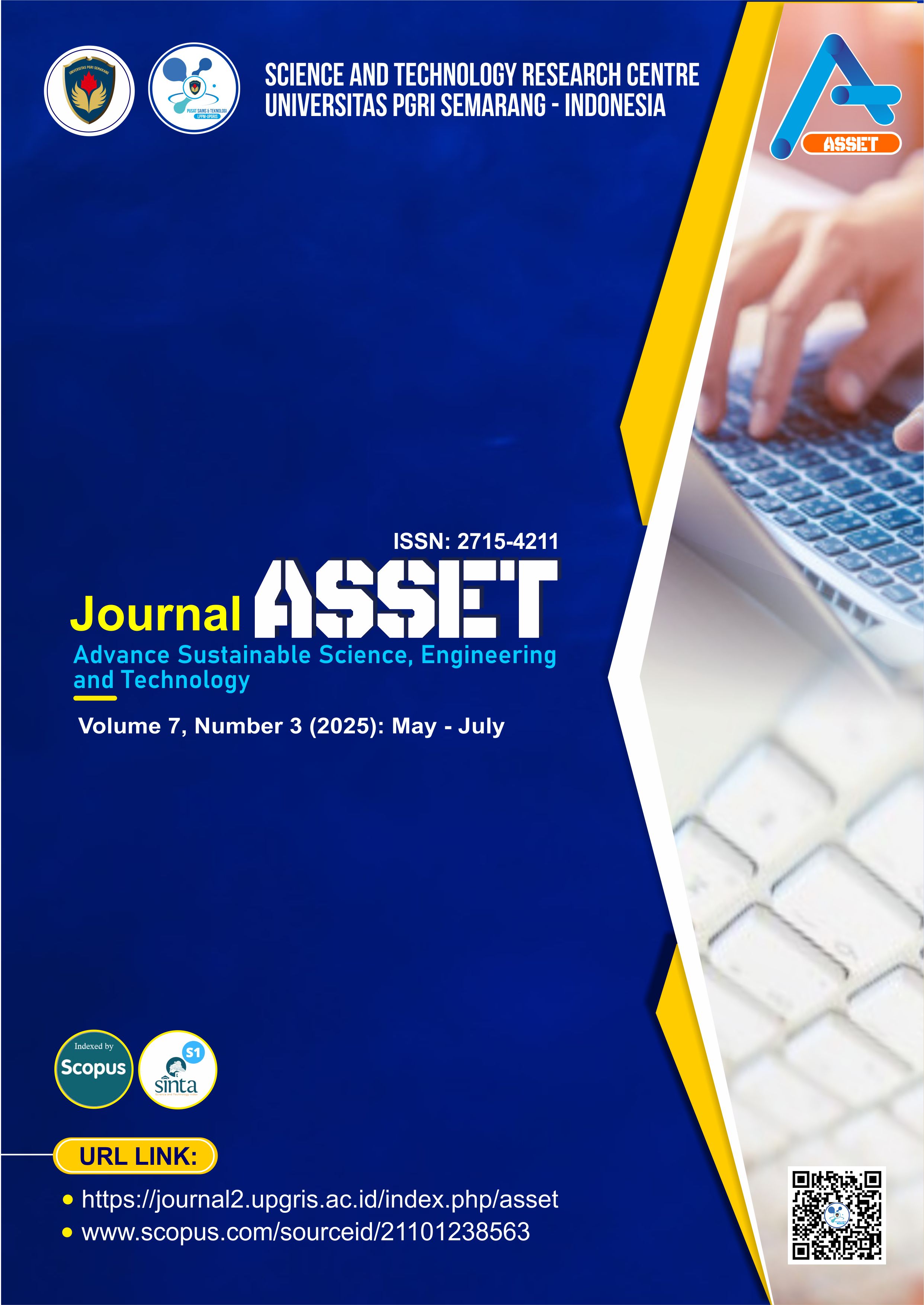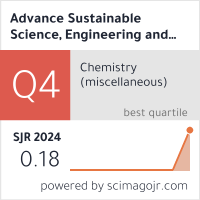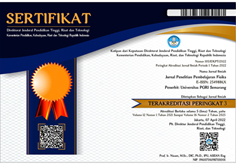Implementation of The Green Campus Concept Based on The UI GreenMetric Guidelines Approach
DOI:
https://doi.org/10.26877/asset.v7i4.2721Keywords:
biodiversity, green campus, green open space, sustainability, UI GreenMetricAbstract
Climate change and rapid urban development have increased the urgency of sustainable practices in higher education institutions. Green areas on campuses play a vital role in reducing carbon emissions, improving microclimate, and supporting ecological balance. This study analyzes the implementation of green area criteria based on the UI GreenMetric World University Rankings 2023 guidelines. A descriptive-analytical method was employed, combining field observations, documentation review, and interviews with campus facilities management. The Green Campus assessment results based on the UI GreenMetric guidelines, UMB is ranked 72nd among universities in Indonesia and 756th in the world based on the UI GreenMetric Ranking 2020. These results suggest that while the campus demonstrates strong compliance with the UI GreenMetric benchmarks, further improvement in conservation and community engagement is necessary.
References
[1] Luki Safriana, Nurhayati, Widiyani, and Didik Suharjito, “Narrative-Driven Optimization for Sustainable Museum Networks: Integrating Freytag’s Pyramid and Hybrid PSO-Machine Learning Framework,” Adv. Sustain. Sci. Eng. Technol., vol. 7, no. 4, p. 0250401, 2025, doi: 10.26877/qa9r7832.
[2] K. Javan, M. Mirabi, S. A. Hamidi, M. Darestani, A. Altaee, and J. Zhou, “Enhancing Environmental Sustainability in a Critical Region: Climate Change Impacts on Agriculture and Tourism,” Civ. Eng. J., vol. 9, no. 11, pp. 2630–2648, 2023, doi: 10.28991/CEJ-2023-09-11-01
[3] H. Saputri, Dita Meilinda; Albert Eddy, “Life Cycle Cost Analysis in Dynamic Modeling on High Rise Green Retrofit Office Building,” AIP Conf. Proc., vol. 2710, no. 1, 2024, doi: 10.1063/5.0144138.
[4] A. E. Husin et al., “Optimizing Time Performance in implementing Green Retrofitting on High-Rise Residential by using System Dynamics and M-PERT,” Civ. Eng. J., vol. 9, no. 12, pp. 3060–3074, 2023, doi: 10.28991/CEJ-2023-09-12-07.
[5] W. T. Ator, E. Damayanti, M. N. Rohman, and A. E. Husin, “Sustainability assessment with the green retrofitting concept for building: A study case in the Gresik regency, Indonesia,” J. Infrastructure, Policy Dev., vol. 8, no. 12, pp. 1–18, 2024, doi: 10.24294/jipd.v8i12.7896.
[6] L. Sun, R. Lian, W. Gao, M. Zhao, and H. Wang, “Evaluating Green Campus Environments in Chinese Universities from Subjective Perceptions: A Textual Semantic and Importance–Performance Analysis Through a Satisfaction Survey,” Land, vol. 14, no. 4, 2025, doi: 10.3390/land14040878.
[7] A. E. Husin et al., “Cost Efficiency of Retrofitting Green Chemical Industrial Buildings,” Civ. Eng. J., vol. 10, no. 3, pp. 714–728, 2024, doi: 10.28991/CEJ-2024-010-03-04.
[8] Universitas Indonesia, UI GreenMetric. 2019. [Online]. Available: https://greenmetric.ui.ac.id/wp-content/uploads/2019/07/UI_GreenMetric_Guideline_2019_Indonesian.pdf
[9] H. S. Shange, L. K. J. Zogli, and B. I. Dlamini, “Green campus initiatives and strategies for sustainability in higher education,” Transform. High. Educ., vol. 10, pp. 1–9, 2025, doi: 10.4102/the.v10i0.364.
[10] J. E. Fuentes, C. E. Garcia, and R. A. Olaya, “Estimation of the setting and infrastructure criterion of the ui greenmetric ranking using unmanned aerial vehicles,” Sustainability, vol. 14, no. 1, 2022, doi: 10.3390/su14010046.
[11] P. Aregarot, K. Kubaha, and S. Chiarakorn, “A Study of Sustainability Concepts for Developing Green Universities in Thailand,” Sustainability, vol. 16, no. 7, 2024, doi: 10.3390/su16072892.
[12] K. Verheyen et al., “Universities as frontrunners in the effort towards green and biodiverse cities?,” Urban For. Urban Green., vol. 81, no. February, p. 127872, 2023, doi: 10.1016/j.ufug.2023.127872.
[13] J. Ha and H. J. Kim, “The restorative effects of campus landscape biodiversity: Assessing visual and auditory perceptions among university students,” Urban For. Urban Green., vol. 64, no. February, p. 127259, 2021, doi: 10.1016/j.ufug.2021.127259.
[14] F. Zhang and H. Qian, “A comprehensive review of the environmental benefits of urban green spaces,” Environ. Res., vol. 252, no. December 2023, 2024, doi: 10.1016/j.envres.2024.118837.
[15] A. Chatzimentor, E. Apostolopoulou, and A. D. Mazaris, “A review of green infrastructure research in Europe: Challenges and opportunities,” Landsc. Urban Plan., vol. 198, no. February, p. 103775, 2020, doi: 10.1016/j.landurbplan.2020.103775.
[16] Z. Barnett-Itzhaki et al., “Strategies and challenges for green campuses,” Front. Sustain. Cities, vol. 7, 2025, doi: 10.3389/frsc.2025.1469274.
[17] T. Gomez and V. Derr, “Landscapes as living laboratories for sustainable campus planning and stewardship: A scoping review of approaches and practices,” Landsc. Urban Plan., vol. 216, p. 104259, 2021, doi: 10.1016/j.landurbplan.2021.104259.
[18] V. Gherheș, G. M. Dragomir, M. Cernicova-Buca, and A. Palea, “Enhancing Sustainability in University Campuses: A Study on Solid Waste Generation and Disposal Practices among Students in Politehnica University Timisoara, Romania,” Sustain., vol. 16, no. 16, 2024, doi: 10.3390/su16166866.
[19] A. A. M. Muhiddin, Ha. M. Isa, S. R. M. Sakip, O. M. Nor, and D. S. Sedhu, “Green Campus Implementation in the Malaysian Public Universities: Challenges and solutions,” J. Malaysian Inst., vol. 21, no. 1, pp. 274–298, 2023. doi: 10.21837/pm.v21i25.1239
[20] D. Chasokela, “Greening the Campus: Strategies for Sustainable Transformation in Higher Education,” J. Educ. Sustain. Dev. Stud., vol. 2, no. 1, pp. 1–17, 2025, doi: 10.70232/jesds.v2i1.16.
[21] J. M. F. Domingos, D. G. Marques, V. Campos, and M. A. Nolasco, “Analysis of the Water Indicators in the UI GreenMetric Applied to Environmental Performance in a University in Brazil,” Sustainability, vol. 16, no. 20, 2024, doi: 10.3390/su16209014.
[22] R. F. Sari, N. Suwartha, H. Setiani, and Y. A. Sidiyanto, “The Impact of UI GreenMetric Involvement on Universities’ Performance in Shaping a Sustainable Campus,” J. Sustain. Perspect., pp. 399–414, 2023, doi: 10.14710/jsp.2023.20847.
[23] N. A. Malek, M. Mariapan, and N. I. A. A. Rahman, “Community Participation in Quality Assessment for Green Open Spaces in Malaysia,” Procedia - Soc. Behav. Sci., vol. 168, pp. 219–228, 2015, doi: 10.1016/j.sbspro.2014.10.227.
[24] A. Sugiarto, C. W. Lee, and A. D. Huruta, “A Systematic Review of the Sustainable Campus Concept,” Behav. Sci. (Basel)., vol. 12, no. 5, 2022, doi: 10.3390/bs12050130.
[25] R. Setiowati, H. S. Hasibuan, and R. H. Koestoer, “Green open space masterplan at Jakarta Capital City, Indonesia for climate change mitigation,” IOP Conf. Ser. Earth Environ. Sci., vol. 200, no. 1, 2018, doi: 10.1088/1755-1315/200/1/012042.











